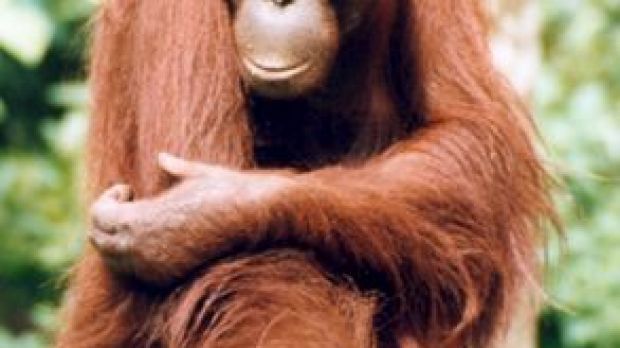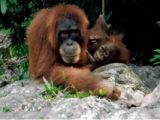A comparative study has demonstrated an evolutionary link between food availability and brain size in living apes.
Orangutans are the only big apes from Asia. Their habitat is strictly limited to the Indonesian islands of Borneo and Northern Sumatra. Adult males - twice larger than females - are about 4.5 ft (1.4 m) tall and up to 82 kg in weight.
Scientists found that orangutans living in northeastern Borneo, Pongo pygmaeus morio (photo above), where food supplies were more limited, have smaller brains than those from the rest of Borneo and Sumatra. "Temporary, unavoidable food scarcity may select for a decrease in brain size, perhaps accompanied by only small or subtle decreases in body size," said Andrea Taylor, from Duke's departments of Biological Anthropology and Anatomy, and Carel van Schaik, director the University of Zurich's Anthropological Institute.
"To our knowledge, this is the first such study to demonstrate a relationship between relative brain size and resource quality at this microevolutionary level in primates," they said.
Their finding supports the "expensive tissue" hypothesis. "Compared to other tissues, brain tissue is metabolically expensive to grow and maintain," Taylor said.
"If there has to be a trade-off, brain tissue may have to give."
"The study suggests that animals facing periods of uncontrollable food scarcity may deal with that by reducing their energy requirement for one of the most expensive organs in their bodies: the brain," van Schaik added.
"This brings us closer to a good ecological theory of variation in brain size, and thus of the conditions steering cognitive evolution. Any adaptive benefits from a larger brain must exceed the extra energy required to grow and maintain the larger brain tissue. Such a theory is vital for understanding what happened during human evolution, where, relative to our ancestors, our lineage underwent a threefold expansion of brain size in a few million years."
Indivduals of Sumatran orangutans, Pongo abelii, (photo bellow) differed most from morio subspecies, one of the three living in Borneo. Sumatra has rich volcanic soils, best for growing the fruits that the orangutans need, and have a more stable rainfall pattern. The morio subspecies lives in the northeastern Borneo, where soils are poorer and El Ni?o, a meteorological event that brings drought, can have a more significant impact; these are all factors that "converge to produce an environment for orangutans of eastern Borneo that is at times seriously resource-limited".
During fruit shortage, the morio orangutans have to "resort to fallback foods with reduced energy and protein content, such as vegetation and bark," they added. The morio form has stronger jaws adapted to tougher food than other orangutans. "This improved feeding efficiency, coupled with a relatively small brain, would enable such animals to adapt to their conditions by both maximizing their resources and conserving energy," she said.
It also seems that Bonreo subspecies bears offspring more frequently than Sumatra subspecies. "Such relatively short intervals between births could themselves be tied to smaller brains in such higher primates as orangutans. Larger-brained apes have slower-paced life histories. Assuming selection is acting on brain size, life history is prolonged because development of larger brains require more time." researchers said.
"We see greater anatomical differences amongst the Bornean populations than we see between the Bornean and Sumatran populations," Taylor said.
"The effects of El Ni?o on tropical rain forest composition and diversity are more marked in eastern compared to western parts of Borneo"
The team used for their measurements 226 adult skulls from museums and other sources, belonging to the four distinct subspecies occupying Sumatra and Borneo. Pongo pygmaeus morio "consistently exhibit the absolutely and relatively smallest cranial capacity," the researchers concluded.
The brain reduction was more statistically significant for females. Morio females are notably smaller than morio males and pregnancy, lactation and their smaller homes ranges might put them under a higher nutritional stress. "The general scenario supported by these results, then, is that an increase in the frequency of uncontrollable periods of low energy intake in one part of the orangutan's geographic range selected for a reduction in brain size," the researchers said.
"Similar evolutionary pressures within resource-poor environments also may explain the smaller-than-normal brain size of a controversial 18,000-year-old skull recently found on the Indonesian island of Flores".
But strong evidences rather suggest a modern human with microcephaly, a genetic disorder characterized by an abnormally small head and usually an underdeveloped brain.

 14 DAY TRIAL //
14 DAY TRIAL // 
